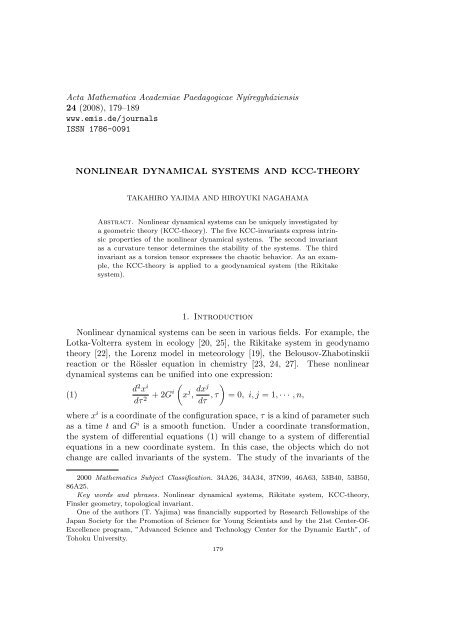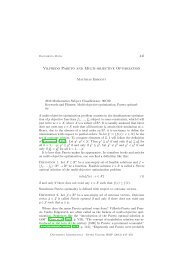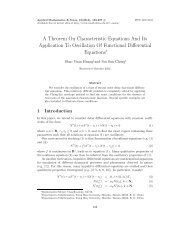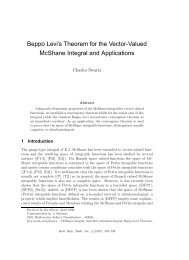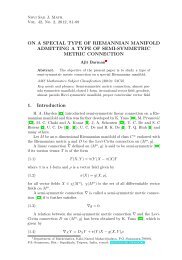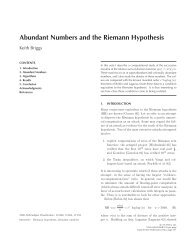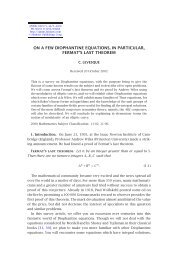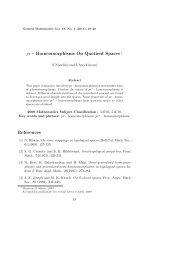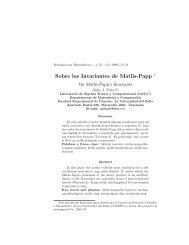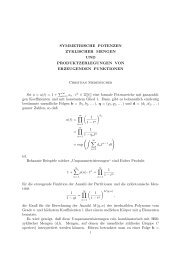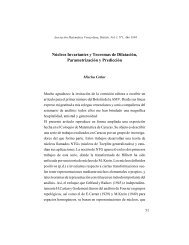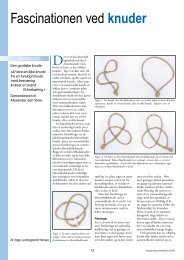NONLINEAR DYNAMICAL SYSTEMS AND KCC-THEORY
NONLINEAR DYNAMICAL SYSTEMS AND KCC-THEORY
NONLINEAR DYNAMICAL SYSTEMS AND KCC-THEORY
You also want an ePaper? Increase the reach of your titles
YUMPU automatically turns print PDFs into web optimized ePapers that Google loves.
Acta Mathematica Academiae Paedagogicae Nyíregyháziensis<br />
24 (2008), 179–189<br />
www.emis.de/journals<br />
ISSN 1786-0091<br />
<strong>NONLINEAR</strong> <strong>DYNAMICAL</strong> <strong>SYSTEMS</strong> <strong>AND</strong> <strong>KCC</strong>-<strong>THEORY</strong><br />
TAKAHIRO YAJIMA <strong>AND</strong> HIROYUKI NAGAHAMA<br />
Abstract. Nonlinear dynamical systems can be uniquely investigated by<br />
a geometric theory (<strong>KCC</strong>-theory). The five <strong>KCC</strong>-invariants express intrinsic<br />
properties of the nonlinear dynamical systems. The second invariant<br />
as a curvature tensor determines the stability of the systems. The third<br />
invariant as a torsion tensor expresses the chaotic behavior. As an example,<br />
the <strong>KCC</strong>-theory is applied to a geodynamical system (the Rikitake<br />
system).<br />
1. Introduction<br />
Nonlinear dynamical systems can be seen in various fields. For example, the<br />
Lotka-Volterra system in ecology [20, 25], the Rikitake system in geodynamo<br />
theory [22], the Lorenz model in meteorology [19], the Belousov-Zhabotinskii<br />
reaction or the Rössler equation in chemistry [23, 24, 27]. These nonlinear<br />
dynamical systems can be unified into one expression:<br />
(1)<br />
d2xi + 2Gi<br />
dτ 2<br />
�<br />
x j , dxj<br />
, τ<br />
dτ<br />
�<br />
= 0, i, j = 1, · · · , n,<br />
where x i is a coordinate of the configuration space, τ is a kind of parameter such<br />
as a time t and G i is a smooth function. Under a coordinate transformation,<br />
the system of differential equations (1) will change to a system of differential<br />
equations in a new coordinate system. In this case, the objects which do not<br />
change are called invariants of the system. The study of the invariants of the<br />
2000 Mathematics Subject Classification. 34A26, 34A34, 37N99, 46A63, 53B40, 53B50,<br />
86A25.<br />
Key words and phrases. Nonlinear dynamical systems, Rikitate system, <strong>KCC</strong>-theory,<br />
Finsler geometry, topological invariant.<br />
One of the authors (T. Yajima) was financially supported by Research Fellowships of the<br />
Japan Society for the Promotion of Science for Young Scientists and by the 21st Center-Of-<br />
Excellence program, ”Advanced Science and Technology Center for the Dynamic Earth”, of<br />
Tohoku University.<br />
179
180 TAKAHIRO YAJIMA <strong>AND</strong> HIROYUKI NAGAHAMA<br />
second order differential equations is called the <strong>KCC</strong>-theory (the general pathspace<br />
theory of Kosambi [17], Cartan [7] and Chern [8]). Then, one can find five<br />
<strong>KCC</strong>-invariants for the system (1) under the coordinate transformation [1, 2, 4].<br />
Therefore, the <strong>KCC</strong>-theory is useful for studying the intrinsic properties of the<br />
nonlinear dynamical systems.<br />
In the following sections, geometric descriptions of the nonlinear dynamical<br />
systems are shown based on the <strong>KCC</strong>-theory. In section 2, the <strong>KCC</strong>-theory is<br />
briefly reviewed. In section 3, it is shown that nonlinear dynamical systems<br />
can be uniquely investigated by the <strong>KCC</strong>-theory. In section 4, the <strong>KCC</strong>-theory<br />
is applied to the geodynamical system (the Rikitake system) and the <strong>KCC</strong>invariants<br />
are obtained. In section 5, the chaotic behavior of the Rikitake system<br />
is discussed by using the geometric invariants. It is remarked that our results<br />
are extension of some results of [26].<br />
2. Geometric preliminary<br />
In this section, the geometric background of this study is briefly explained<br />
based on the notations [1, 2, 3, 4]. Throughout this paper, Einstein’s summation<br />
convention is used and Latin indices i, j, k, . . . run from 1 to n.<br />
Now, let M be a real smooth n-dimensional manifold, and (T M, π, M) be<br />
its tangent bundle (phase space), where π : T M → M is a projection from the<br />
total space T M to the base manifold M. A point x ∈ M has local coordinates<br />
(x i ), where i = 1, . . . n. The local chart of a point u ∈ T M is denoted by<br />
(x i , y i ), where y i = dx i /dt and t is a time. The time t is regarded as an absolute<br />
invariant. Therefore, a non-singular coordinate transformation is given by<br />
(2) ˜t = t, ˜x i = ˜x i (x 1 , x 2 , . . . , x n ).<br />
Let us consider an equation of a path c(t) = (x i (t)) as<br />
d<br />
(3)<br />
2xi dt2 + 2Gi (x j , y j , t) = 0,<br />
where Gi (xj , yj ) is a smooth function. Then, under the non-singular coordinate<br />
transformations (2), the <strong>KCC</strong>-covariant differential of a vector field ξi (t) along<br />
the path c(t) is<br />
(4)<br />
Dξi dt<br />
= dξi<br />
dt + N i jξ j ,<br />
where N i j is a coefficient of the nonlinear connection defined by N i j = ∂Gi /∂y j<br />
[1]. Moreover, when ξ i = y i , the covariant differential is<br />
Dy<br />
(5)<br />
i<br />
dt = N i jy j − 2G i ≡ −ɛ i ,<br />
where the contravariant vector field ɛi is called the first <strong>KCC</strong>-invariant. When<br />
the first invariant does not vanish, the path of the second order differential equations<br />
does not coincide with the autoparallel curve of the nonlinear connection.
<strong>NONLINEAR</strong> <strong>DYNAMICAL</strong> <strong>SYSTEMS</strong> <strong>AND</strong> <strong>KCC</strong>-<strong>THEORY</strong> 181<br />
It is shown from expression (26) in section 4 that the first invariant means the<br />
external force of the system.<br />
Next, let us consider that the trajectory x i (t) of the system (3) is changed<br />
into nearby ones according to<br />
(6) ¯x i (t) = x i (t) + ξ i (t)η,<br />
where η is a small parameter. Substituting (6) in (3) and taking the limit η → 0,<br />
one gets the variational equation<br />
d<br />
(7)<br />
2ξi dt2 + 2N i dξ<br />
l<br />
l<br />
+ 2∂Gi<br />
dt ∂xl ξl = 0.<br />
Using the covariant differential (4), one can rewrite (7) in the covariant form<br />
(8)<br />
where<br />
D 2 ξ i<br />
dt 2 + Bi jξ j = 0,<br />
(9) B i j = 2 ∂Gi<br />
∂xj + 2GlG i jl − y l ∂N i j<br />
∂xl − N i l N l j − ∂N i j<br />
∂t .<br />
Here, the Gi jk ≡ ∂N i j /∂yk , it is a Finsler connection (Berwald connection).<br />
The Bi j is the second invariant or the deviation curvature tensor and gives the<br />
stability of whole trajectories (the Jacobi stability) [4]. In engineering field,<br />
this variational equation called the hunting equation has been introduced in<br />
order to study a stability of electrical machine systems in non-Riemannian space<br />
[15, 16, 18] and in Finsler space [11]. On the other hand, the linear stability<br />
theory is the theory on a local stability around a point on the tangent space [5].<br />
This means that the behavior of the nonlinear dynamical systems is described on<br />
the tangent bundle T M. In this case, the equation (3) is a first order differential<br />
equation with respect to yi and the Jacobi stability equation (7) is reduced to<br />
the equation of a linear stability theory. Therefore, the Jacobi stability gives a<br />
more global stability than the linear stability.<br />
The third invariant is defined by<br />
(10) B i jk = δN i j<br />
where δ/δx i is given by<br />
(11)<br />
δxk − δN i k ,<br />
δxj δ ∂ j ∂<br />
= − N<br />
δxi ∂xi i .<br />
∂yj Because of the skew symmetry of lower indices j and k, the third invariant<br />
is regarded as a torsion tensor. The third invariant is also called the curvature<br />
plays a role<br />
tensor of the nonlinear connection N i j [1]. In this case, the tensor Bi jk<br />
of field strength and the nonlinear connection is interpreted as the potential. The<br />
fourth and fifth invariants are given by Bi jkl = ∂Bi kl /∂yj and Di jkl = ∂Gi jk /∂yl ,<br />
respectively. These fourth and fifth invariants are curvature tensors. The fourth
182 TAKAHIRO YAJIMA <strong>AND</strong> HIROYUKI NAGAHAMA<br />
invariant expresses the rate of change of the torsion in the phase space. The<br />
is also called Douglas tensor [9]. By the definition, the fifth<br />
fifth invariant Di jkl<br />
invariant vanishes if and only if the Gi is a quadratic in yi . This means that<br />
two variables interact each other for Di jkl = 0. In case of Di jkl �= 0, there are<br />
more higher interactions. Therefore, the fifth invariant expresses a measure of<br />
interactions in the system.<br />
3. A relation between nonlinear dynamical systems and the<br />
<strong>KCC</strong>-theory<br />
As mentioned in the introduction, nonlinear dynamical systems generally take<br />
the form (1). In this section, it is shown that the <strong>KCC</strong>-theory can be applied to<br />
the various nonlinear dynamical systems.<br />
In ecology, the Lotka-Volterra system is a simplified model of predator and<br />
prey population dynamics. The two species Lotka-Volterra system is expressed<br />
by the non-tensor form [20, 25]:<br />
(12)<br />
(13)<br />
dN 1<br />
dt = N 1 (ã − ˜bN 2 ),<br />
dN 2<br />
dt = −N 2 (˜c − ˜ dN 1 ),<br />
where the ã, ˜ b, ˜c and ˜ d are constant parameters. The N i is a population species<br />
given by the production variable x i , i.e. N i = dx i /dt. Therefore, this system<br />
can be regarded as the system of second order differential equations (1). Thus,<br />
the ecological system can be studied by the <strong>KCC</strong>-theory, and the geometrical<br />
properties have been obtained [2, 3, 4].<br />
In the Earth sciences, the above equation (1) can describe some nonlinear<br />
geodynamical systems, the Lorenz model in meteorology and the Rikitake system<br />
in geodynamo theory.<br />
The Rikitake system is a unified electro-mechanical system which describes<br />
the chaotic behavior of magnetic field (Figure 1). This system consists of two<br />
rotating conductive discs coupled with electrically each other. The equations of<br />
motion are derived from the Faraday’s law [26] and written by [22]:<br />
(14)<br />
L 1 dI<br />
1<br />
1<br />
J 3 3<br />
dt + R1 1I 1 = M 1 23I 2 ω 1 , L 2 dI<br />
2<br />
2<br />
dt + R2 2I 2 = M 2 14I 1 ω 2 ,<br />
dω1 dt = F 3 − M 3 12I 1 I 2 , J 4 dω<br />
4<br />
2<br />
dt = F 4 − M 4 12I 1 I 2 ,<br />
where the variables, I i and ω i , represent the current and the angular velocity<br />
with the subscripts corresponding to the system number I or II, respectively. The<br />
coefficients (L 1 1, L 2 2), (R 1 1, R 2 2), (J 3 3 , J 4 4 ) and (F 3 , F 4 ) are the self-inductances,<br />
resistances, moments of inertia and driving couples, respectively. The indices of<br />
the coefficients 1 and 2 express the electrical part of system I and II, respectively.<br />
The indices of the coefficients 3 and 4 express the mechanical part of system I
<strong>NONLINEAR</strong> <strong>DYNAMICAL</strong> <strong>SYSTEMS</strong> <strong>AND</strong> <strong>KCC</strong>-<strong>THEORY</strong> 183<br />
Figure 1. The Rikitake system (modified from [22])<br />
and II, respectively. M i jk is the mutual-inductance. For example, M 1 23 is the interaction<br />
between the current I 2 and the angular velocity ω 1 . These coefficients<br />
are all positive constants. Moreover, the current and the angular velocity are<br />
expressed by the differentials with respect to the electric charge and the angle<br />
of rotating discs, respectively. Thus, the Rikitake system can be regarded as the<br />
second order system (1) and has been geometrized based on the <strong>KCC</strong>-theory<br />
[26].<br />
The Lorenz model simulates thermal convections in the atmosphere. The<br />
Lorenz equations are expressed by the following equations [19]:<br />
(15)<br />
(16)<br />
(17)<br />
dX<br />
= σ(Y − X),<br />
dt<br />
dY<br />
= −XZ + ρX − Y,<br />
dt<br />
dZ<br />
= −λZ + XY,<br />
dt<br />
where X is a speed of motion of the air, Y and Z denote the temperature<br />
differences. The σ, ρ and λ are constant parameters. These equations can be<br />
rewritten in the form of one second order differential equation (1), when one<br />
variable is excluded. For example, after excluding the variable Z, the above<br />
equations are equivalent to the geodesic equation, Y ′′ + F (X, Y, Y ′ ) = 0, in<br />
Finsler space [10], where Y ′ = dY/dX. Therefore, the Lorenz model can be<br />
discussed in terms of the <strong>KCC</strong>-theory in Finsler space.
184 TAKAHIRO YAJIMA <strong>AND</strong> HIROYUKI NAGAHAMA<br />
The nonlinear dynamical phenomena can be also found in chemistry. The<br />
Belousov-Zhabotinskii reaction is a nonlinear chemical system in a nonequilibrium<br />
state [27]. The equations of motion are expressed by:<br />
(18)<br />
(19)<br />
(20)<br />
dX<br />
dt = r(Y − X Y + X − qX 2 ),<br />
dY<br />
dt = r−1 (−Y − X Y + pZ),<br />
dZ<br />
= w(X − Z),<br />
dt<br />
where the p, q, r and w are constant parameters. The X , Y and Z represent<br />
concentrations of the reactants. As well as the Lorenz model, after eliminating<br />
one of the variables Z, these equations can be written in the form of the second<br />
order differential equation, Y ′′ + H(X , Y, Y ′ ) = 0. Moreover, motivated by the<br />
search for chemical chaos, it has been proposed the Rössler equation, which<br />
contains just one nonlinear term of second order [23, 24]. Since this equation<br />
is a simplification of the equation of the Belousov-Zhabotinskii reaction, the<br />
Rössler equation is also equivalent to the second order differential equation in<br />
Finsler space [6]. Hence, the nonlinear chemical systems are regarded as the<br />
second order system (1) and can be geometrically studied by the <strong>KCC</strong>-theory.<br />
The equation (1) expresses nonlinear phenomena in physics, chemistry, earth<br />
science and ecology. Therefore, the nonlinear dynamical systems can connect<br />
with the geometrical concept via the <strong>KCC</strong>-theory and Finsler geometry. Then,<br />
the five <strong>KCC</strong>-invariants express the chaotic behavior of the various nonlinear<br />
dynamical systems (1).<br />
4. Application of the <strong>KCC</strong>-theory to the Rikitake system<br />
In this section, the <strong>KCC</strong>-theory applies to the Rikitake system, and the geometrical<br />
invariants are obtained.<br />
The equations of motion of the Rikitake system are given by (14). In order<br />
to study geometrically, let us consider 4-dimensional manifold M with a coordinate<br />
(x i ) = (q 1 , q 2 , θ 1 , θ 2 ), where (x 1 , x 2 ) and (x 3 , x 4 ) are the electric charge<br />
(q 1 , q 2 ) and the angle of rotating discs (θ 1 , θ 2 ), respectively. Then let (x i , y i )<br />
denote natural coordinates in a local chart of the tangent bundle T M, where<br />
(y 1 , y 2 , y 3 , y 4 ) = (I 1 , I 2 , ω 1 , ω 2 ). In the following, the Latin indices i, j, k, . . .<br />
run 1 to 4.<br />
At first, the equations of motion (14) and the nonlinear connection N i j are<br />
expressed by<br />
(21)<br />
(22)<br />
y i = dxi<br />
dt ,<br />
N i j = G i kjy k − 1<br />
2 γi j.<br />
dy i<br />
dt = −Gi jky j y k + γ i jy j + f i ,
<strong>NONLINEAR</strong> <strong>DYNAMICAL</strong> <strong>SYSTEMS</strong> <strong>AND</strong> <strong>KCC</strong>-<strong>THEORY</strong> 185<br />
Here, the coefficients are<br />
⎧<br />
⎪⎨ G<br />
(23)<br />
⎪⎩<br />
1 23 = G1 32 = − M 1 23<br />
2L1 , G<br />
1<br />
2 14 = G2 41 = − M 2 14<br />
2L2 ,<br />
2<br />
(24)<br />
(25)<br />
G 3 12<br />
= G 3 21 = M 3 12<br />
2J 3 3<br />
γ 1 1 = −2N 1 1 = − R1 1<br />
L 1 1<br />
f 1 = f 2 = 0, f 3 =<br />
, G4 12 = G4 21 = M 4 12<br />
2J 4 ,<br />
4<br />
, γ 2 2 = −2N 2 2 = − R2 2<br />
L2 , γ<br />
2<br />
3 3 = γ 4 4 = 0,<br />
3 F<br />
J 3 , f<br />
3<br />
4 =<br />
4 F<br />
J 4 .<br />
4<br />
The constant Berwald connection (23) plays an important role of interactions<br />
between the electrical system and the mechanical system. For example, the<br />
connection G 3 12 ∝ M 3 12 implies the interaction between the currents I 1 and I 2 .<br />
Next, let us consider the geometric invariants of the Rikitake system. The<br />
first invariant of the Rikitake system is given by (5)<br />
(26) ɛ 1 = R1 1<br />
2L1 I<br />
1<br />
1 , ɛ 2 = R2 2<br />
2L2 2<br />
I 2 , ɛ 3 3 F<br />
= − , ɛ 4 4 F<br />
= − .<br />
The components of the first invariant consist of the voltages R 1 1I 1 , R 2 2I 2 and the<br />
driving couples F 3 , F 4 . Therefore, the ɛi represents an external force.<br />
The Douglas tensor Di jkl<br />
of motion (14) are quadratic with the constant Berwald connection Gi jk<br />
shows that the fourth invariant Bi jkl is reduced to Bi jkl = 2Gm j[kGi l]m<br />
as the fifth invariant vanishes because the equations<br />
. This<br />
, where<br />
Gm j[kGi l]m = (Gm jkGi lm − Gm jl Gi km )/2.<br />
The third invariant as the torsion tensor (10) is expressed by the nonlinear<br />
connection and the Berwald connection:<br />
(27) B i kj = G i mjN m k − G i mkN m j .<br />
The nonlinear connection N i j can be regarded as the projection from the (yi )field<br />
to the (yj )-field. This shows that the torsion tensor Bi jk is characterized<br />
by the interactions between electrical system and mechanical system.<br />
Finally, using the third invariant, the second invariant as the deviation curvature<br />
tensor is can be derived from the coefficient of the hunting equation (8):<br />
D2ξi �<br />
+ 2G<br />
dt2 m j[kGil]m yjy k �<br />
+ −γ m j G i ml + 1<br />
2 γm l G i mj + 1<br />
2 γi mG m �<br />
lj y j<br />
−G i lhf h − 1<br />
4 γi mγ m �<br />
l ξ l (28)<br />
= 0.<br />
It is known that the system is Jacobi stable if and only if the real parts of<br />
the eigenvalues of the second invariant Bi j are strictly positive everywhere, and<br />
Jacobi unstable otherwise [4]. In particular, eigenvalues of the second invariant<br />
J 3 3<br />
J 4 4
186 TAKAHIRO YAJIMA <strong>AND</strong> HIROYUKI NAGAHAMA<br />
at the origin (x i 0, y i 0) = (0, 0) are µ1 = µ2 = 0, µ3 = (−R 2 J +2F ML)/4L 2 J and<br />
µ4 = −(R2J + 2F ML)/4L2J, where for the simplification, we put M i jk ≡ M,<br />
Li j ≡ L, J i j ≡ J, Ri j ≡ R and F i ≡ F . Also, these coefficients are all positive.<br />
Therefore, the Rikitake system is Jacobi unstable at the origin for µ4 < 0. Hence,<br />
the stability of whole trajectories can be determined by this second invariant.<br />
Generally, for the Berwald connection, the two curvature tensors Bi jkl , Di jkl<br />
and one torsion tensor Bi jk survive [3]. In the Rikitake system, the Douglas<br />
tensor Di jkl disappears. Hence, the curvature Bi jkl and the torsion Bi jk can<br />
represent the behavior of the Rikitake system.<br />
5. Discussion<br />
The Rikitake system can be regarded as a unified system which is splitted<br />
into electrical and mechanical systems. On the other hand, Ikeda [13, 14] has<br />
discussed the unified field theory of electromagnetism and gravitation based<br />
on Lagrange geometry [21]. In this Ikeda’s theory, the nonlinear connection<br />
N i j is interpreted as an electromagnetic potential and the torsion tensor Bi jk<br />
means an electromagnetic field tensor. Therefore, the electrical system and the<br />
mechanical system in the Rikitake system correspond to the electromagnetic<br />
field and the gravitational field in the Ikeda’s theory, respectively. Hence, the<br />
unified structures in the Rikitake system can be studied in the same framework<br />
of the Ikeda’s geometrical unified theory [12] in the Lagrange space [21]. In the<br />
following, the aperiodic behavior of the Rikitake system is discussed based on<br />
the nonlinear connection and the torsion tensor.<br />
Let us consider a projected trajectory in the (I 1 , I 2 )-plane. The trajectory<br />
is not closed because the Rikitake system behaves chaotically. In this case, the<br />
discrepancy ∆I1 along the trajectory C is given by the nonlinear connection<br />
(29) ∆I 1 �<br />
= dy 1 �<br />
= − N 1 αdx α �= 0,<br />
C<br />
where we use the following relation given by the equation (21):<br />
(30)<br />
dy 1 = −N 1 αdx α<br />
C<br />
= −(N 1 j dx j + N 1 0 dt).<br />
Here, the Greek indices run from 0 to 4 and we put x 0 ≡ t, y 0 ≡ 1 and N 1 0 ≡ ɛ 1 .<br />
Moreover, using the Stokes’ theorem and the equation (30), the integral of the<br />
nonlinear connection is<br />
�<br />
−<br />
(31)<br />
C<br />
N 1 αdx α �<br />
= −<br />
= 1<br />
2<br />
�<br />
S<br />
S<br />
dN 1 α ∧ dx α<br />
B 1 αβdx α ∧ dx β ,<br />
where S is a region inside the trajectory C and the ∧ is an exterior product.<br />
Thus, the torsion tensor expresses the discrepancy ∆I 1 given by the projection
<strong>NONLINEAR</strong> <strong>DYNAMICAL</strong> <strong>SYSTEMS</strong> <strong>AND</strong> <strong>KCC</strong>-<strong>THEORY</strong> 187<br />
from the mechanical field to the electrical field:<br />
(32) ∆I 1 �<br />
= − N 1 αdx α = 1<br />
�<br />
B<br />
2<br />
1 αβdx α ∧ dx β �= 0.<br />
C<br />
Similarly, a mechanical discrepancy ∆ωi can be obtained by a projection from<br />
the electrical field to the mechanical field. The above relation (32) shows that<br />
N 1 α and B1 αβ mean the potential and the field strength in the Rikitake system,<br />
respectively. With this correspondence, the discrepancy implies an electromagnetic<br />
phase difference around a trajectory in the Aharonov-Bohm effect [14].<br />
Therefore, the aperiodic behavior due to the phase difference ∆I1 can be expressed<br />
by the torsion tensor B1 αβ as the interaction between the electrical system<br />
and the mechanical system. Moreover, topologically, the aperiodic behavior corresponds<br />
to a turbulent motion by the Chern-Simons number which expresses<br />
the interaction between an electromagnetic field and a hydrodynamic motion<br />
[26]. Hence, the discrepancy ∆I1 as the phase difference can be represented by<br />
the topological invariant (the Chern-Simons number).<br />
S<br />
6. Conclusion<br />
Geometrically, the nonlinear dynamical systems in various fields can be<br />
uniquely expressed by the <strong>KCC</strong>-theory. Then, the geometric invariants for the<br />
nonlinear dynamical systems are obtained. As an example, the <strong>KCC</strong>-theory is<br />
applied to a geodynamo model (the Rikitake system). The first invariant of the<br />
Rikitake system means the external force. The second invariant as the curvature<br />
tensor determines the stability of the Rikitake system. The third invariant (the<br />
torsion tensor) implies the discrepancy given by a projection from the unified<br />
electromechanical field to the subspace as the mechanical field or the electrical<br />
field. Because this discrepancy relates to the topological invariant as the<br />
Chern-Simons number, the aperiodic behavior can be expressed by the topological<br />
invariant. The fourth invariant consists of the constant Berwald connection.<br />
The fifth invariant vanishes because the equations of motion of the Rikitake system<br />
are quadratic. As well as the Rikitake system, the intrinsic properties of<br />
other nonlinear dynamical systems can be represented by the <strong>KCC</strong>-theory.<br />
Acknowledgments<br />
The authors would like to thank to the anonymous referee for the helpful and<br />
valuable comments on our manuscript.<br />
References<br />
[1] P. L. Antonelli and I. Bucătaru. New results about the geometric invariants in <strong>KCC</strong>theory.<br />
An. S¸tiint¸. Univ. Al. I. Cuza Ia¸si. Mat. (N.S.), 47(2):405–420, 2001.<br />
[2] P. L. Antonelli and I. Bucataru. Volterra-Hamilton production models with discounting:<br />
general theory and worked examples. Nonlinear Anal. Real World Appl., 2(3):337–356,<br />
2001.
188 TAKAHIRO YAJIMA <strong>AND</strong> HIROYUKI NAGAHAMA<br />
[3] P. L. Antonelli, R. S. Ingarden, and M. Matsumoto. The theory of sprays and Finsler<br />
spaces with applications in physics and biology, volume 58 of Fundamental Theories of<br />
Physics. Kluwer Academic Publishers Group, Dordrecht, 1993.<br />
[4] P. L. Antonelli, S. F. Rutz, and V. S. Sabău. A transient-state analysis of Tyson’s model<br />
for the cell division cycle by means of <strong>KCC</strong>-theory. Open Syst. Inf. Dyn., 9(3):223–238,<br />
2002.<br />
[5] V. I. Arnol ′ d. Ordinary differential equations. Springer Textbook. Springer-Verlag, Berlin,<br />
1992. Translated from the third Russian edition by Roger Cooke.<br />
[6] L. A. Bordag and V. S. Dryuma. Investigation of dynamical systems using tools of the<br />
theory of invariants and projective geometry. Z. Angew. Math. Phys., 48(5):725–743, 1997.<br />
[7] E. Cartan. Observations sur le mémoire précédent. (Extrtait d’une lettre à<br />
M. D. D. Kosambi). Math. Z., 37(1):619–622, 1933.<br />
[8] S.-S. Chern. Sur la géométrie d’un système d’équations différentielles du second ordre.<br />
Bull. Sci. Math., 63:206–212, 1939.<br />
[9] J. Douglas. The general geometry of paths. Ann. of Math. (2), 29(1-4):143–168, 1927/28.<br />
[10] V. S. Dryuma. Geometrical properties of the multidimensional nonlinear differential equations<br />
and the Finsler metrics of phase spaces of dynamical systems. Teoret. Mat. Fiz.,<br />
99(2):241–249, 1994.<br />
[11] M. Fujinaka. On Finsler spaces and dynamics with special reference to equations of hunting.<br />
In Proceedings of the Third Japan National Congress for Applied Mechanics, 1953,<br />
pages 433–436, Tokyo, 1954. Science Council of Japan.<br />
[12] S. Ikeda. A geometrical construction of the physical interaction field and its application to<br />
the rheological deformation field. Tensor (N.S.), 24:60–68, 1972. Commemoration volumes<br />
for Prof. Dr. Akitsugu Kawaguchi’s seventieth birthday, Vol. I.<br />
[13] S. Ikeda. Some remarks on the Lagrangian theory of electromagnetism. Tensor (N.S.),<br />
49(2):204–208, 1990.<br />
[14] S. Ikeda. On the theory of gravitational field in Finsler spaces. Tensor (N.S.), 50(3):256–<br />
262, 1991.<br />
[15] T. Kawaguchi. On the design variation of the simplified induction machine based on the<br />
theory of hyper-film space. Tensor, N. S., 26:277–290, 1972.<br />
[16] K. Kondo and Y. Ishizuka. Recapitulation of the geometrical aspects of Gabriel Kron’s<br />
non-Riemannian electrodynamics. In Memoirs of the unifying study of the basic problems<br />
in engineering sciences by means of geometry. Vol. I, pages 185–239. Gakujutsu Bunken<br />
Fukyu-Kai, Tokyo, 1955.<br />
[17] D. D. Kosambi. Parallelism and path-spaces. Math. Z., 37(1):608–618, 1933.<br />
[18] G. Kron. Non-Riemannian dynamics of rotating electrical machinery. J. Math. Phys.,<br />
Mass. Inst. Techn., 13:103–194, 1934.<br />
[19] E. N. Lorenz. Deterministic nonperiodic flow. J. Atmos. Sci., 20(2):130–141, 1963.<br />
[20] A. J. Lotka. Elements of physical biology. Williams and Wilkins Company, Baltimore,<br />
1925.<br />
[21] R. Miron and M. Anastasiei. The geometry of Lagrange spaces: theory and applications,<br />
volume 59 of Fundamental Theories of Physics. Kluwer Academic Publishers Group,<br />
Dordrecht, 1994.<br />
[22] T. Rikitake. Oscillations of a system of disk dynamos. Proc. Cambridge Philos. Soc.,<br />
54:89–105, 1958.<br />
[23] O. E. Rössler. An equation for continuous chaos. Phys. Lett., 57A(5):397–398, 1976.<br />
[24] O. E. Rössler and K. Wegmann. Chaos in the Zhabotinskii reaction. Natrure, 271:89–90,<br />
1978.<br />
[25] V. Volterra. Variations and fluctuations of the number of individuals in animal species<br />
living together. J. Cons. Int. Explor. Mer., 3(1):3–51, 1928.
<strong>NONLINEAR</strong> <strong>DYNAMICAL</strong> <strong>SYSTEMS</strong> <strong>AND</strong> <strong>KCC</strong>-<strong>THEORY</strong> 189<br />
[26] T. Yajima and H. Nagahama. <strong>KCC</strong>-theory and geometry of the Rikitake system. J. Phys.<br />
A, 40(11):2755–2772, 2007.<br />
[27] A. M. Zhabotinskii. Periodic oxidizing reactions in the liquid phase (in russian). Dokl.<br />
Akad. Nauk. SSSR, 157(2):392–395, 1964.<br />
Department of Geoenvironmental Sciences,<br />
Graduate School of Science,<br />
Tohoku University, 6-3 Aoba-ku, Sendai 980-8578, Japan<br />
E-mail address: yajima@dges.tohoku.ac.jp


